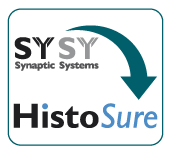|
|
|
|
| Cat. No. HS-477 008 |
50 µg purified recombinant IgG, lyophilized. Albumin and azide were added for stabilization. For reconstitution add 50 µl H2O to get a 1mg/ml solution in PBS. Then aliquot and store at -20°C to -80°C until use. Antibodies should be stored at +4°C when still lyophilized. Do not freeze! |
| Applications | |
| Clone | Rb17F7 |
| Subtype | IgG1 (κ light chain) |
| Immunogen | Synthetic peptide corresponding to residues near the amino terminus of mouse Galectin-3 (UniProt Id: P16110) |
| Reactivity |
Reacts with: mouse (P16110). No signal: human (P17931), rat. Other species not tested yet. |
| Remarks |
This antibody is a chimeric antibody based on the monoclonal rat antibody SY-17F7. The constant regions of the heavy and light chains have been replaced by rabbit specific sequences. The antibody can therefore be used with standard anti-rabbit secondary reagents. The antibody has been expressed in mammalian cells. |
| Data sheet | hs-477_008.pdf |
 Important information
Important information|
|
Galectin-3 (Gal-3, Mac-2) is a β-galactoside binding protein that is predominantly located in the cytoplasm and shuttles into the nucleus. In addition, it is secreted to the cell surface and into biological fluids. Depending on its localization, it exerts pleiotropic biological functions like cell growth, cell differentiation, inflammation, fibrogenesis, migration, apoptosis and host defense (1). It is also involved in cancer pathogenesis, proliferation and spreading of metastasis (2). Galectin-3 is highly expressed in the covering epithelia of the digestive tract and the urinary system (3) and plays important roles in the organization of renal and intestinal cells. Furthermore, Galectin-3 has been identified in a variety of other cell types including fibroblasts, keratinocytes, granulocytes, dendritic cells and macrophages (2). Galectin-3 is expressed by certain tissue-resident macrophages such as Kupffer cells in the liver, red pulp macrophages in the spleen and alveolar macrophages in the lung (3). In the brain, Galectin-3 is abundant in activated microglia but not expressed in resting cells. Following brain injury, Galectin-3 triggers anti-inflammatory properties of microglia (4). In Alzheimer’s disease, Gal-3 expression is strictly associated with microglial cell activation around Aβ plaques. In stroke Gal-3 was found to be expressed primarily in proinflammatory microglial cells (5).